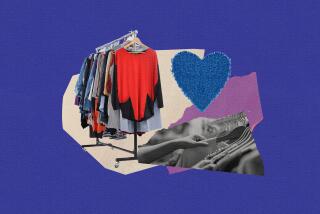Hooked on Shopping? Thereâs Help : Addictions: Therapistâs book offers a 14-point recovery plan.
âEveâ is a shop-âtil-you-dropper who regularly controls her urge to charge it by placing her charge cards in the freezer. But when sheâs bent on another binge-and-splurge episode, she microwaves the plastic back to life.
âJessicaâ lives on a remote island off the East Coast but still packs in six hours of shopping every day. This despite the fact that sheâs limited to one department store and a few hotel gift shops.
The source of this information is Carolyn Wesson, a Silicon Valley psychotherapist, who found herself with a progression of patients like Eve and Jessica and discovered that a lot of beautiful clothes dressed some less-than-beautiful stories.
A self-proclaimed shopaholic, Wesson has written âWomen Who Shop Too Much: Overcoming the Urge to Splurgeâ (St. Martinâs Press).
Wesson found out that the addiction extends far beyond Imelda Marcos, the grand lady of conspicuous consumption, with her 508 floor-length gowns, 15 mink coats and 2,700 pairs of shoes.
One can easily encounter a shopaholic and not even know it, since many do not possess an impressive designer wardrobe.
âI buy a lot of things I donât need, mainly because theyâre on sale,â confides an Orange County woman, in debt because of her daily lunch hour sprees.
All told, an estimated 59 million American women use shopping as a way of coping with psychological problems, âstumbling to the nearest store for retail therapy,â says Wesson. She limits the scope of her book to women because men tend toward other addictions such as alcohol, drugs, work and sports.
Wesson offers a self-assessment quiz, indicating the characteristics of addicted shoppers: They routinely shop to avoid their emotions; they begin their shopping sprees with heart-palpitating highs but retreat with regret, self-recrimination and depression; they suddenly spend more without apparent reason; they may fall into substantial debt; they often buy things they never use.
If you flunk the quiz, help is available through Wessonâs 14-point recovery plan and through organizations such as Debtors Anonymous.
The author theorizes that excessive shopping usually stems from the same causes as other addictions, such as âlow self-esteem, a lonely childhood, parents who withheld love, emotional stress, an unhappy marriage or love relationship, a recent breakup--all of which gives rise to feelings of deprivation and the urge to acquire possessions, even useless ones.â
To develop her theory of shopaholism, Wesson attended conventions and training sessions for Adult Children of Alcoholics, a national organization. She did numerous studies of addictive personalities she treated in private practice and read extensively on the addictive personality.
Wesson notes that Los Angeles has an atmosphere particularly conducive to shopaholism. âBecause of the movie and TV industry, there is an enormous emphasis on looks and appearances,â she says. âRodeo Drive is a mecca, the ultimate shopping experience, and one of the L.A. musts for women who shop too much.â


